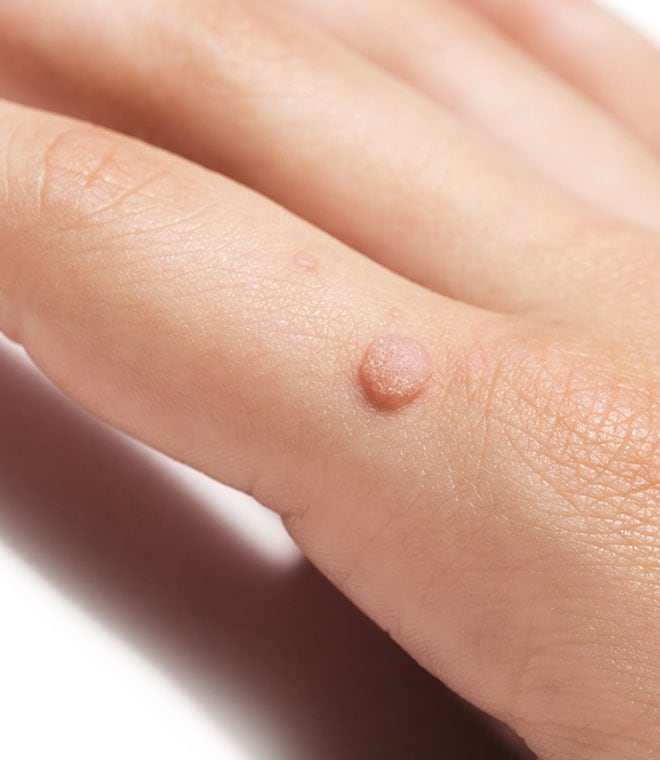Health
Skin tag vs. wart: What's the difference?
By Anna H. Chacon, MD, Fellow of the American Academy of Dermatology Jun 19, 2024 • 6 min
Although skin tags and warts may have some similarities, they aren’t the same thing. Here you’ll find out what warts and skin tags are, along with the major differences between the two.
What are skin tags?
Skin tags are soft skin growths that are often attached to a fleshy stalk. They may be skin-colored, brown or red, and most measure between 1 and 5 millimeters. In rare cases, they can grow up to 2 centimeters in size.
What are warts?
Warts are hard, rough skin growths that can grow as large as a pea — or larger, depending on the type of wart. Warts may be white, flesh-colored or light brown, and some types may have black dots in the center that look like seeds.
Who gets skin tags?
Between 50% and 60% of adults will develop a skin tag in their lifetime. Although they may appear during the teenage or early adulthood years, they’re more common in people who are in their 40s, 50s and 60s. As people age, their skin tags may grow, increasing in size. People may also develop more skin tags with age. They commonly occur in people with obesity, diabetes or a family history of skin tags.
Who gets warts?
Warts are very common among children and teens, but people of any age can get a wart. Most people will have a wart in their lifetime — and some people may have a large number of them.
Where do skin tags occur?
Skin tags usually grow where the skin folds or rubs against itself, such as the underarms, groin, eyelids and neck.
Where do warts occur?
Warts most commonly grow on the hands and fingers (common warts) or on the bottoms of the feet and toes (plantar warts), where a cut or other trauma has occurred. Some warts, including flat warts and filiform warts, often grow on the face, and periungual warts grow underneath or around the toenails and fingernails.
What causes skin tags?
While the cause of skin tags is unknown, they’ve been found to be associated with type 2 diabetes, heart disease, obesity and genetic factors, as well as with frequent skin irritation, aging of the skin and hormonal imbalances. The human papilloma virus, or HPV, is present in many, but not all, skin tags. A genetic disorder known as Birt-Hogg-Dube syndrome is characterized by a large number of skin tags.
What causes warts?
Warts are caused by the human papilloma virus, or HPV. Common warts and plantar warts are caused by different strains of the virus than genital warts or anal warts, which are sexually transmitted.
Are skin tags harmful?
Skin tags aren’t contagious, and they’re generally harmless. But while they’re not painful, skin tags may get caught on clothing or jewelry, and if the skin tag experiences constant friction from clothes or the body, it may itch or bleed. Skin tags don’t necessarily need to be removed, but if a skin tag appears to be changing or becomes painful, you should seek medical care.
Are warts harmful?
Most warts are harmless, although plantar warts on the bottoms of the feet may be painful, and mosaic warts, which grow in clusters, may be embarrassing. Warts are contagious and may spread to other parts of the body or to other people. Children with common warts on their hands or fingers often spread the warts to their face through touch or by mouth. Anal and genital warts may be associated with an increased risk of anal, genital or cervical cancer. If you suspect you have these types of warts, visit your healthcare provider.
How are skin tags treated?
If skin tags are troublesome or unsightly, you can have them removed by a healthcare professional, who will freeze them with cryosurgery, burn them off with electrocautery, or cut them off via snip excision.
How are warts treated?
While they’re generally harmless, removing warts can help stop their spread. Certain warts can be treated at home with over-the-counter wart removal products containing salicylic acid and other chemicals, or they can be removed by your healthcare provider with similar methods used to remove skin tags.
While skin tags and warts are generally harmless, you can always have them removed if you wish. If a skin tag or wart causes embarrassment or emotional distress because of its conspicuous location, or if it bleeds or becomes painful or infected, visit your healthcare provider.
Clinically reviewed and updated by Julie McDaniel, MSN, RN, CRNI, June 2024.
Sources:
- https://www.ncbi.nlm.nih.gov/books/NBK547724/
- https://www.ncbi.nlm.nih.gov/books/NBK279586/
- https://www.aocd.org/page/SkinTags
- https://www.health.harvard.edu/a_to_z/skin-tags-acrochordon-a-to-z
- https://www.merckmanuals.com/professional/dermatologic-disorders/benign-skin-tumors,-growths,-and-vascular-lesions/skin-tags
- https://www.aad.org/public/diseases/a-z/skin-tags
- https://www.cancer.org/cancer/types/anal-cancer/causes-risks-prevention/risk-factors.html




